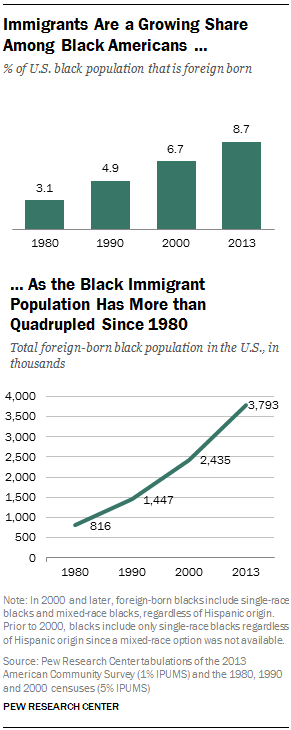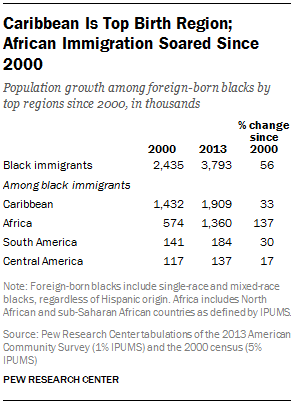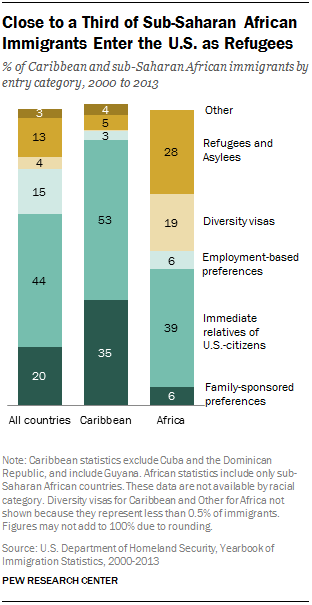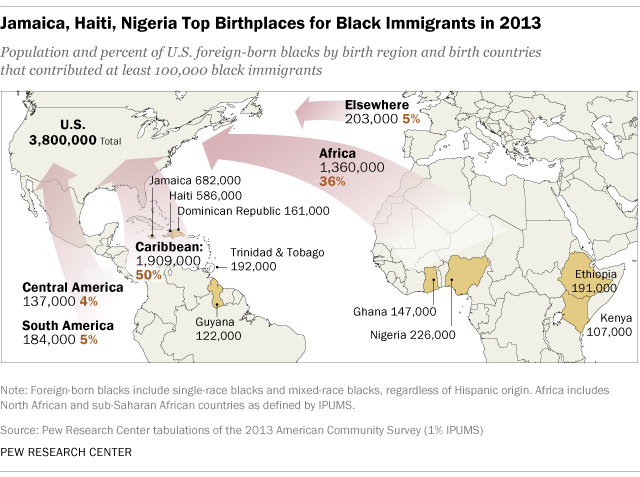Overview


Black immigrants are from many parts of the world, but half are from the Caribbean alone.1 Jamaica is the largest source country with about 682,000 black immigrants born there, accounting for 18% of the national total. Haiti follows with 586,000 black immigrants, making up 15% of the U.S. black immigrant population.

Many black immigrants are from Spanish-speaking countries. Among these, the Dominican Republic is the largest country of birth, accounting for 161,000 black immigrants. Mexico is also a source of black immigration with roughly 70,000 black immigrants. Some 41,000 are from Cuba, and 32,000 are Panamanian. Moreover, 11% of the foreign-born black population identifies as Hispanic.
The History of Black Migration to the U.S.
The United States has long had a significant black population.2 In the nation’s earliest censuses (at the end of the 18th century), blacks accounted for nearly one-fifth of the U.S. population, with nearly all brought to the U.S. as slaves from Africa. Today, most of the nation’s 40 million U.S.-born blacks trace their roots to this population.
However, due to the outlawing of the slave trade in 1808 as well as restrictions on non-European immigration, the flow of blacks arriving in the U.S. dropped to a trickle for more than a century and a half. Among the black immigrants who voluntarily migrated during this time, most were from the Caribbean.

The modern wave of black immigration to the U.S. began when U.S. immigration policy changed in the 1960s, becoming more open to a wider variety of migrants. Just like other immigrants, foreign-born blacks benefited from the Immigration and Nationality Act of 1965 that emphasized family reunification and skilled immigrant labor.3 In addition, the Refugee Act of 1980 loosened immigration restrictions by allowing more immigrants from conflict areas such as Ethiopia and Somalia to seek asylum in the U.S.4 Finally, the U.S. Immigration Act of 1990 sought to increase the number of immigrants from underrepresented nations, and although the act was initially intended to increase the flow of European immigrants, Africans have benefited from the program, as well.5
This act, also known as the diversity visa program, has been an important way for African immigrants to gain entry into the U.S. About one-in-five sub-Saharan African immigrants (19%) who gained legal permanent residence between 2000 and 2013 entered through this program.
During the same period, about three-in-ten (28%) sub-Saharan African immigrants arrived in the U.S. as refugees or asylees. That share was only 5% for Caribbean immigrants and 13% for the overall immigrant population. Caribbean immigrants are much more likely to enter the U.S. through family-sponsored
Caribbean and sub-Saharan African immigrants are less likely to have been granted admittance via employment-based visa programs than immigrants overall.6
A Statistical Portrait of Black Immigrants

Compared with the U.S. population overall, black immigrants have a slightly higher median age (42 years versus 37 years) and among those that are ages 25 and up, are slightly less likely to have a college degree (26% versus 30%). In addition, black immigrants are less likely than all Americans to own their homes (40% versus 64%), and overall they have lower household incomes.
These findings are based on a Pew Research Center analysis of data from the 2013 American Community Survey in addition to analyses of the 1980, 1990 and 2000 U.S. decennial censuses. The report explores the characteristics of the nation’s black immigrant population in 2013 and how it has changed since 2000. It also compares the characteristics of black immigrants with those of U.S.-born blacks, all U.S. immigrants and the U.S. population.

CORRECTION (Jan. 17, 2018): In the report text, the total number of black immigrants from the Dominican Republic was changed to 161,000 (it incorrectly said 166,000).
About This Report
This report explores the demographic, economic and geographic characteristics, as well as population trends, of the black foreign-born population in the United States. Black immigrants are defined as those current U.S. residents born outside the U.S. who indicate that their race is black or is mixed-race black, regardless of Hispanic origin. The report also compares the characteristics of black immigrants to U.S.-born blacks, foreign-born U.S. residents and the general U.S. population. Immigrant population estimates include all immigrants regardless of citizenship or legal status.
The data for this report are from four main sources. The first is the U.S. Census Bureau’s 2013 American Community Survey, which provides the most recent detailed geographic, demographic and economic characteristics for foreign-born blacks, U.S.-born blacks, foreign-born U.S. residents and the general U.S. population. The other data sources are the 1980, 1990 and 2000 decennial censuses (5% IPUMS).
The report was written by Monica Anderson, research analyst. Editorial guidance was provided by Mark Hugo Lopez, director of Hispanic research; Kim Parker, director of social trends research; D’Vera Cohn, senior writer; Claudia Deane, vice president of research; and Juliana Menasce Horowitz, associate director for research. Eileen Patten, research analyst; Ana Gonzalez-Barrera, research associate; and Anna Brown, research assistant, provided research assistance. Anna Brown number checked the report. Marcia Kramer was the copy editor. Related reports are online at www.pewresearch.org/pewresearch-org/hispanic and at www.pewresearch.org/pewresearch-org/social-trends.
A Note on Terminology
The terms “black immigrants” and “foreign-born blacks” are used interchangeably throughout the report and refer to persons who were both born outside the United States, Puerto Rico or other U.S. territories and whose race is black or is mixed-race black, regardless of Hispanic origin, in 2000 and later U.S. Census Bureau surveys. For previous census years (1980 and 1990), “black immigrants” or “foreign-born blacks” refer to persons born outside the U.S., Puerto Rico or other U.S. territories whose race is black, regardless of Hispanic origin. Prior to 2000, respondents to Census Bureau surveys and its decennial census could make only one selection in the race question. In 2000 and later, respondents were able to indicate they were of more than once race. Immigrant population estimates include all immigrants regardless of citizenship or legal status.
“U.S. born” refers to those who are U.S. citizens at birth, namely people born in the U.S., Puerto Rico or other U.S. territories and those born abroad to at least one parent who was a U.S. citizen.
“Foreign born” refers to people born outside the U.S., Puerto Rico or other U.S. territories to parents neither of whom was a U.S. citizen.
The terms “foreign born” and “immigrant” are used interchangeably.




